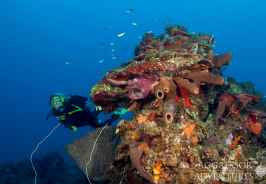Carpe Vita
The BVI Aggressor is a 110’ yacht with a wide beam. Built and powered for comfort, safety and stability, she is diesel-powered, cruises at 10 knots and has 110-volt power onboard. Accommodations include two balcony suites, five deluxe staterooms, each having two single beds or a king, and three twin staterooms each with two single beds, all side by side. All staterooms have climate controls, TV’s and private bathrooms.
The BVI Aggressor sleeps 20 guests in privacy and comfort. She features a roomy, air conditioned salon and dining area, sun deck complete with a hot tub, lounge and deck chairs, an outdoor sound system, shaded cocktail deck, grill, and a photo editing computer for guests to use. Diving amenities include camera table with low-pressure air hoses, and two hot, freshwater showers. The BVI Aggressor staterooms each have a safe aboard to store valuables such as passports, cash, credit cards or anything else you would like to store.
There is a variety of nightly entertainment, including diving, fish identification presentations, movies, games and more. If you have a favorite movie or digital presentation to share, we encourage you to bring it along. The staff especially loves new releases of movies, recent magazines and books. A small library of books for exchange is maintained onboard as well as fish identification books for reference. All meals, snacks and beverages are provided.
The British Virgin Islands (BVI) are known for lush green mountains, powdery white-sand beaches and turquoise waters.. The BVI are a British overseas territory comprised of four large islands – Tortola, Virgin Gorda,, Jost Van Dyke, Anageda and 50 smaller islands and cays. The wreck of the Rhone, one of the world’s best shipwreck dives, is a highlight of the trip along with beautiful coral gardens, seamounts, canyons and sandy bottoms.
Balcony Suite - Rooms 9 +10
A comfortable and spacious suite with an outside balcony. The suite has the option of two twin beds or a king with a private bathroom and shower.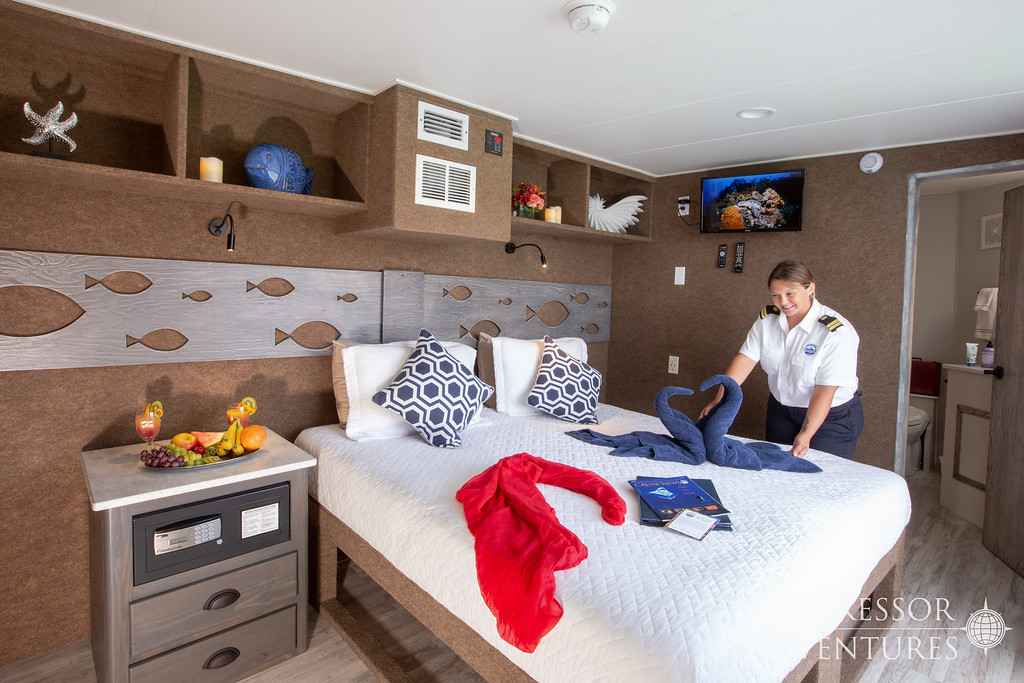
Deluxe Stateroom - Room 3
A comfortable stateroom with a port hole, two single beds or a king bed and a private bathroom and shower.
Twin Stateroom
A comfortable stateroom with two side by side single beds with a private bathroom and shower. Staterooms #1 and #2 do not have a port hole but #4 does.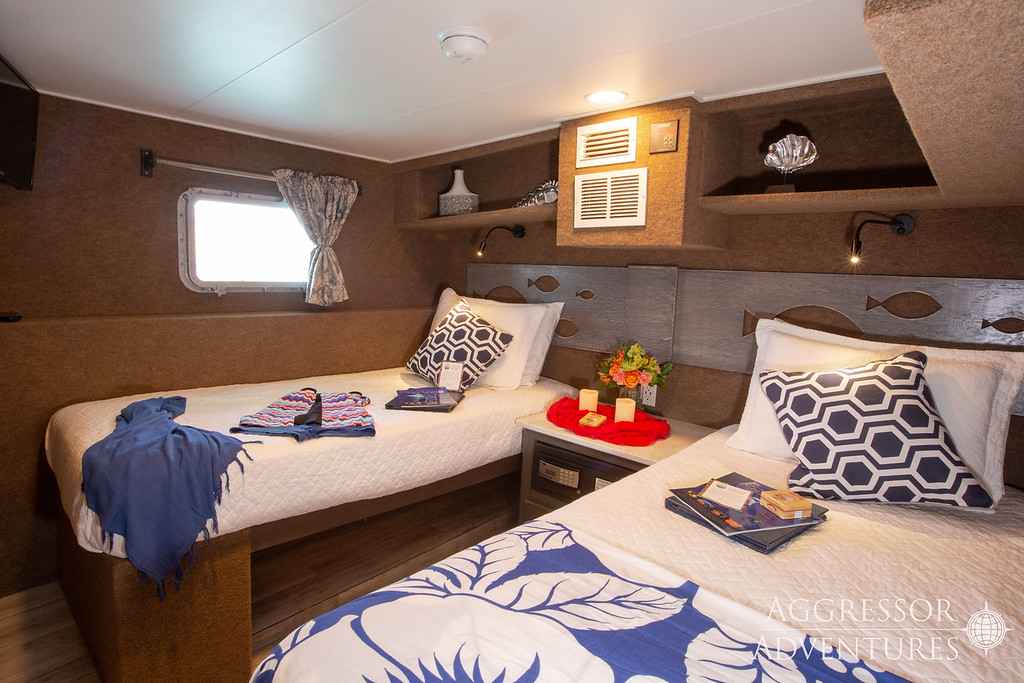
Yacht Specifications
Port: Tortola, British Virgin IslandsBuilt and maintained to the specifications of the local regulatory agencies and the regulations of the country of the flag.
Length: 110 ft.
Beam: 25
Passengers: 20
Staterooms: 10
Boarding: Saturday 4 pm - 5 pm
Check out: Saturday 8 am
The British Virgin Islands starts as an Aggressor destination 2022.
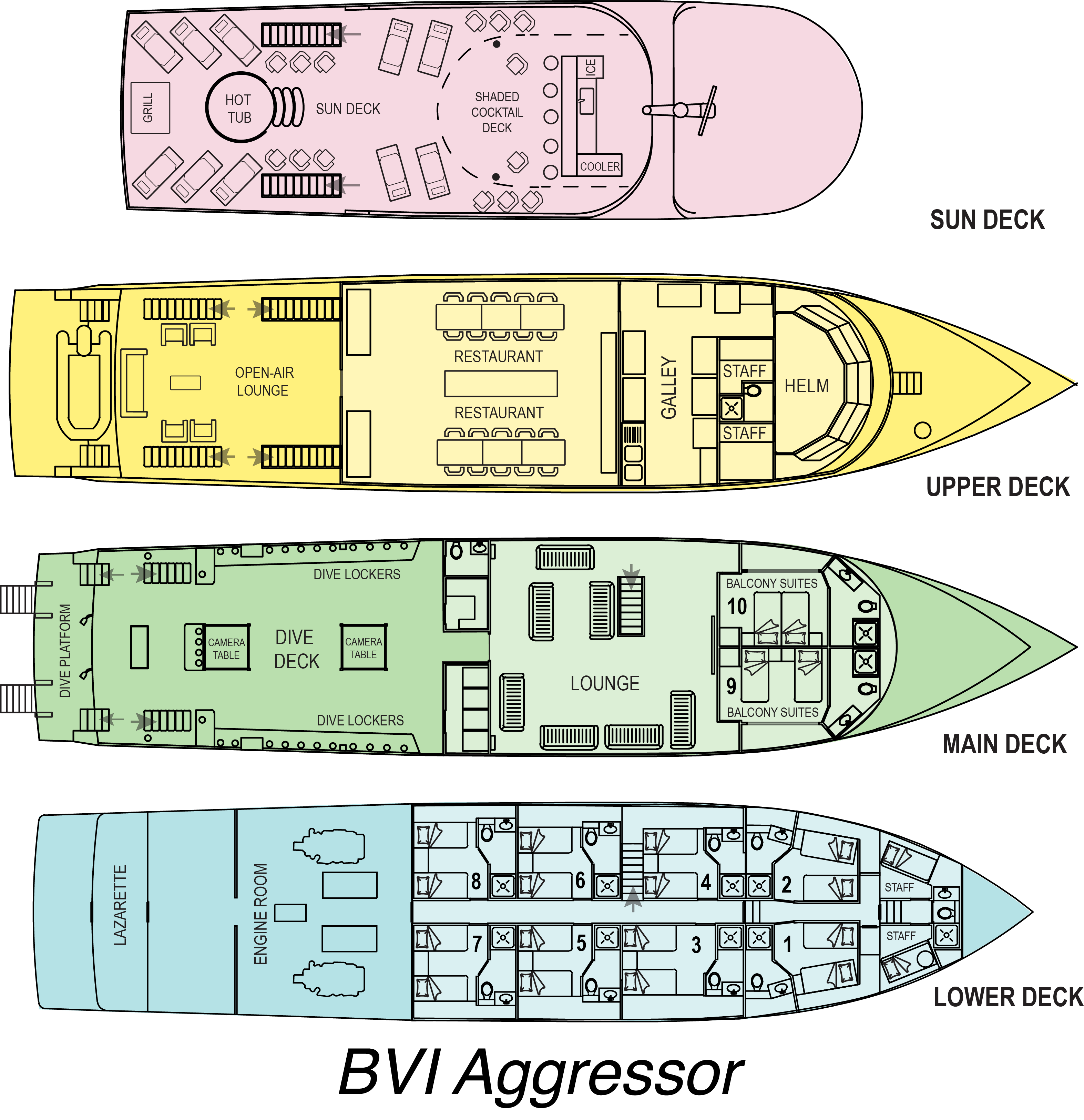
The Trip - you may dive several areas of British Virgin Islands, mainly on the outer islands consisting of Norman, Peter, Salt, Cooper and Virgin Gorda. The itinerary is completely dependent on the winds and weather. Diving begins Sunday morning and ends Friday around noon when the Aggressor returns to port. Average of up to 27 dives on 7 night charters (multiple day dives and a night dive each evening)
All dives are from two large custom built 25 ft. dive tenders.
1 - 3 mm wetsuit recommended
Water temperature range from 76 - 84F, 25 - 28C.
The BVI Aggressor has (2) 25 ft long Highfield Patrol 760 custom dive tenders each outfitted with a 300 hp Suzuki motor, custom tank racks and custom built ladders for easy exit.
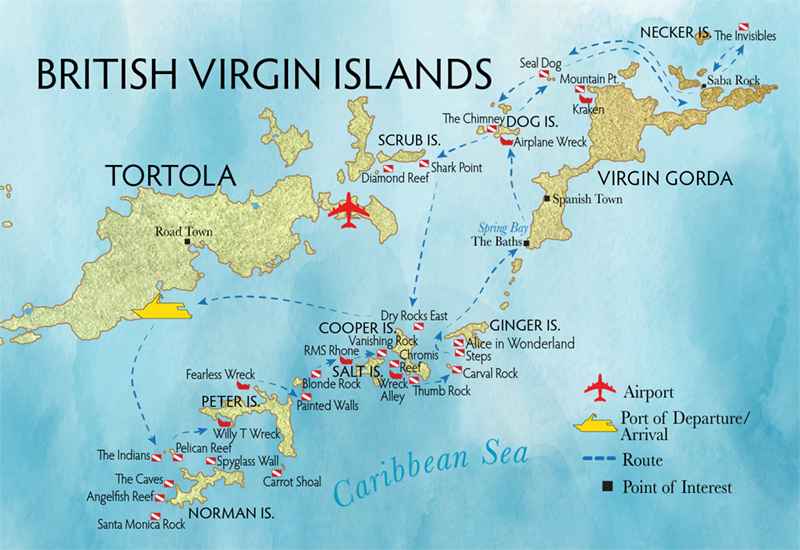
Sample Itinerary:
Norman Island is at the southern tip of the British Virgin Islands archipelago. It is one of many islands reputed to be the inspiration for Robert Louis Stevenson's pirate novel Treasure Island.
The Indians, Norman Island - Four rocky pinnacles create The Indians, a shallow dive a great snorkeling reef. A 15-foot tunnel, and an underwater cavern add o the beautiful underwater terrain. Scores of colorful fish, barracuda and turtles make this one of the BVI’s most famous sites.
Angelfish Reef, Norman Island - Angelfish Reef is best known for its maze of canyons and ridges. Snake eels and Moray eels, turtles, eagle rays, southern stingrays, lobsters and nurse sharks zig and zag through a rainbow of colorful gorgonians. Spotted drums, triple fin blennies, angel fish, sea horses, shrimps, yellowhead jawfish, crustaceans, and anemones make Angelfish Reef a photographer’s dream site.
Spyglass Wall, Norman Island - Spyglass Wall is covered in sea fans, golden tube sponges, purple tube sponges, which create an amazing scene for both snorkelers and scuba divers. A host of marine life includes fairy basslets, damselfish, blue tangs, tobaccofish, anthias, tarpons, Atlantic spadefish, eagle rays, southern stingrays, turtles and squid. It is one of the most captivating mini walls in British Virgin Islands.
Peter Island: The island's largest beach is Deadman's Bay, a mile-long crescent beach shaded by palm trees with a beach, bar, and restaurants. Legend says Deadman's Bay is named for pirates who were marooned on neighboring Dead Chest Island and subsequently drowned swimming to Peter Island.
Carrot Shoal, Peter Island - Carrot Shoal has two open-water pinnacles. Angelfish, butterflyfish, fairy basslets, spotted lobsters, Spanish lobsters, sea turtles, nurse sharks and moray eels populate this, shallow, 60- foot, dive site.
Willy T Wreck and Fearless Wreck, Peter Island - The Fearless is believed to be the sister ship of Cousteau’s Calypso. Willy T was a popular floating bar and restaurant that was scuttled as an artificial reef. Both wrecks are made of wood. Countless black coral trees are home to French grunts, creole wrassses and bar soldier fish.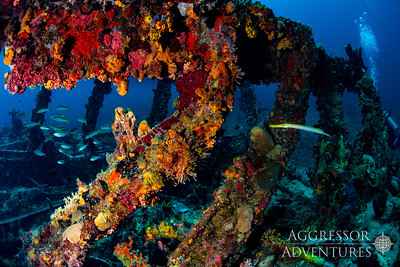
Painted Walls, Peter Island - Painted Walls is awash with a palette of yellow, red, orange, and purple corals. The site’s southern ridge has a huge coral reef that is bustling with macro critters. Hawksbill turtles, lobsters, nurse sharks, barracuda, silversides, tarpons, green moray eels cruise through canyons, a narrow cave and four gullies. This gorgeous site can entertain divers for hours.
Salt Island: It is named after its salt ponds, which were once an important natural resource for islanders.
RMS Rhone shipwreck, Salt Island - In October 1867, a hurricane slammed the 310-feet long, iron-hulled steamship against Black Rock. She broke into two sections. The stern section rests at a depth of 35 feet and the bow section lies at 80 feet. The two sections are about 100 feet apart. The Rhone is considered one of the world’s greatest wrecks and was even part of the 1977 Hollywood thriller, The Deep.
The wreck’s hardware includes its massive bronze propeller, drive shaft and 100-pound wrenches. Numerous artifacts are still intact including black-and-white tiles, a silver teaspoon, glass and metalworks. Nearly every surface of the Rhone is covered in a kaleidoscope of corals.
Coral gardens, cleaning stations and nurseries fill the ship’s remains. Schools of yellowtail snapper, jacks, grunts, and tarpon accompany divers throughout the dives. Macro life includes arrow carbs, shrimp and damsel fish. Turtles, green moray eels, octopus and barracuda are also common seen in this marine park.
An entire day can be spent examining this incredible wreck. Conditions permitting, the Rhone makes a fantastic night dive.
Wreck Alley, Cooper Island - The Marie L, The Island Seal, The Pat and The Beata comprise Wreck Alley. The four wrecks are on the south-western side of Cooper Island, and they lie close to a rich reef wall. Garden eels, stingrays, conchs and octopus hide in the sandy bottom near the Marie L.
Thumb Rock, Cooper Island - A huge pinnacle that resembles a large thumb gave this wonderful site its name. Clear waters and awesome marine life make this a favorite site, so grab your camera. Spotted drums, seahorses, creole wrasses, lobsters can be seen on this shallow dive. Tarpon, French angelfish, queen angelfish, filefish and barracuda make this one of the central BVI’s best stops.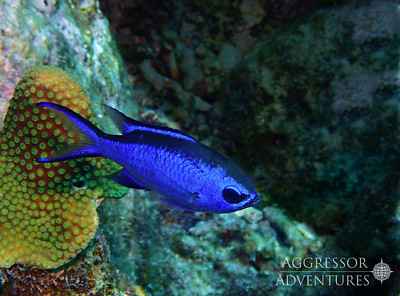
Chromis Reef, Cooper Island - Named for the blue chromis fish and quillfin blennies that populate the gorgonians and coral heads, this reef has good visibility and sandy patches that make it a great site for new divers. Anemones and shrimp hide in the coral heads.
Dry Rocks East - Dry Rocks East is an open water area with beautiful pillar corals, black coral and sea fans that dot the sandy bottom. Since it is an open water site, it offers a chance to spot pelagics like cobia, nurse sharks, barracuda, hawksbill turtles, schools of jacks, and African pompano. French angelfish, black triggerfish, chromis, creole wrasses, coneys, trunkfish and slipper lobsters crowd the huge boulders at the base of the ridge. Ginger Island is one of the last undeveloped privately held islands in the territory. It is the location of two of the more popular dive sites in the British Virgin Islands: "Alice in Wonderland" and "Ginger Steps" - Steps, Ginger Island - Steps, or Ginger Steps, is a plunging three-step wall that descends 90 feet. Good visibility and bright white sand between the rocky drop offs make this a great site for underwater photography. Pompano, octopi, lobster, anthias, barracuda, dolphins, eagle rays and turtles add to the beauty of this amazing site. Alice in Wonderland, Ginger Island - Intricate underwater topography, which consists of narrow channels, sandy canyons and rocky ridges, make this reef truly a Wonderland! This site boasts healthy hard and soft corals, great visibility and a cornucopia of marine life. African pompano, angelfish, parrot fish, moray eels, shrimp, gobies, file fish, scuttling crabs, cleaner shrimp, wrasses dance among colorful gorgonians and elkhorn corals. Turtles and sharks are often seen on this gorgeous reef.
Virgin Gorda: Christopher Columbus is said to have named the island "the Fat Virgin", because the island's profile on the horizon looks like a fat woman lying on her side. Historically renowned, the anchorage off Bitter End was the site of Sir Francis Drake and Sir John Hawkins' 1595 fleet rendezvous, two Elizabethan British admirals who led Britain's ascendance into naval supremacy.
The Baths, Virgin Gorda - The Baths is a collection of massive granite boulders as large as 40 feet in diameter, with white sand beaches and secret rock pools. This awe-inspiring geological wonder creates one of the most iconic images in the Caribbean, a tunnel with towering, angled boulders above shallow, turquoise waters. Snorkeling is available on the beach and surrounding rocks.
Mountain Point, Virgin Gorda - Grunts, parrot fish, angelfish, squirrelfish, butterflyfish, lizardfish, tarpons, jacks, barracuda, permits, garden eels, lobsters and stingrays populate this site that is rarely visited by day boat operators. Resting nurse sharks can be photographed in the smaller caves.
Kraken / Kodiak Queen Wreck, Virgin Gorda - The Kodiak Queen is a US Navy World War II fuel barge. It is believed to be one of the few ships that survived the Japanese surprise attack on Pearl Harbor in 1941. It was set to be scuttled as an artificial reef in 2017, but photographer Owen Buggy and Sir Richard Branson decided to add a unique sculpture to the old barge. An 80-foot Kraken sea monster crafted of metal appears to be attacking the old ship. The Kraken’s tentacles twist and turn around the Kodiak Queen’s stern and wheelhouse.
Seal Dog Rock, Virgin Gorda - Also called, Seal Dogs and Rock, this site has fantastic rock formations with tiny caves, ledges and canyons. Nurse sharks, mackerel, eagle rays, schooling jacks are just a few of the pelagics that cruise these nutrient rich waters.
Shark Point, Scrub Island - Located off the East end of Scrub, Shark Point is an exciting dive with lots of fish including feeding tarpon. Swift currents attract sharks and rays.
The Chimney, Dog Island - Two large rock formations create a gap that resembles a chimney. Bring a flashlight to examine the ledges and overhangs. The Chimney has a large, beautiful archway encrusted with cup corals and brightly colored sponges. The Chimney is a terrific night dive with brittle stars, lobster, flame scallops and scorpionfish.
The Invisibles, Necker Island - The Invisible lie east of Necker Island. (The island is entirely owned by Sir Richard Branson._ The dive site is named for the pinnacles which are invisible from the surface. Swift currents attract an abundance of marine life. Schools of permit gather near the pinnacles’ point. Prolific gold, orange and violet sponges and soft corals give the reef tremendous color.
Jost Van Dyke Island often referred to as JVD or Jost, lies about 8 km (5 mi) to the northwest of Tortola. 17th-century Dutch privateer, Joost van Dyk, an early Dutch settler and former pirate who used Jost van Dyke's harbors as a hideout, may be the name sake of the island. The country music video for Kenny Chesney's 2002 recording "No Shoes, No Shirt, No Problems" was filmed on and around Jost Van Dyke.
Twin Towers / Little Jost Van Dyke - The "Twin Towers" are two large monolithic rock formations rising from 90 feet (27 m). Small canyons and mini caves are filled with fish and schooling squid. Healthy corals are surrounded by French angelfish, grey angelfish, grouper and eagle rays.
* Sample itineraries and maps are for illustrative purposes only. The exact route and sites visited are subject to change based on local regulations, guest experience, weather and logistics, and is at the Captain’s discretion.
To see what the trip is like --- WATCH
